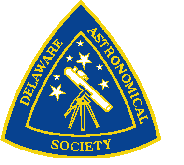

|
Don Shedrick |
April, 2001 |
April DAS Focus
COMPUTERS IN ASTRONOMY by Don Shedrick
The sun is nearing its peak in its 11 year cycle of solar activity, and by the beginning of this month it was really putting on a show. This activity can be monitored from Space Weather.com at:
which provides science news and information about the Sun-Earth environment. From this site, learn about Sunspot 9393, which, as the sunís rotation carried it across the disk, grew to the largest sunspot since 1991, with an area greater than that of 13 planet Earths. The most powerful solar flare of the current solar cycle and the second most powerful since 1976 erupted near the giant sunspot group at 2150 UT on April 2nd. The flux of energetic solar protons around our planet soared to approximately 10,000 times normal.
A powerful geomagnetic storm raged for more than 24 hours over the first weekend in April, dazzling sky watchers who saw aurora borealis as far south as Mexico. The storm began at 0100 UT on March 31st when a coronal mass ejection (CME) struck Earth's magnetosphere. The leading edge of the CME was dense and strongly magnetized -- traits that can (and did) give rise to intense auroras. Veteran aurora watchers describe the display as arguably the most photogenic of the current solar cycle. You can see many stunning images of these auroras from a link on Space Weather site.
Solar Terrestrial Dispatch provides information regarding the state of the sun and its effects on Earth at:
They also develop specialized software for monitoring the sun that is available for downloading. The site has current solar activity reports with various images of the sun, and activity warnings for flare and proton events. The Aurora Monitor has ground based aurora siting reports and near real time space craft images of aurora, and aurora activity watch and warnings. Daily reports have summaries of daily solar and auroral activities. They offer a Space Weather e-mail subscription service for reports, alerts, and warnings of noteworthy events. They also contribute to Sky & Telescopeís AstroAlert Service.
Sky & Telescope has established the AstroAlert e-mail news service
http://skyandtelescope.com/observing/proamcollab/astroalert/default.asp
in collaboration with key organizations of amateur and professional astronomers to alert small-telescope users to significant happenings in the sky -- those that involve especially rare events or require immediate follow-up observations worldwide. To receive e-mail announcements about any type of object or event, just send an e-mail message to the appropriate address listed at the web site. The message will also contain instructions for how, and to whom, to report your own observations. Alerts are available for Comets, Extragalactic Supernovae, Gamma-ray Bursters, Meteors, Minor, Planets, Neutrino-detected Supernovae, Novae, Occultations, Planets, Solar Activity/Auroras/Geophysical Phenomena, and Variable Stars .
For more solar activity information, donít forget the Space Weather Now web site at:
http://www.sec.noaa.gov/SWN/index.html
which was featured in the December Focus article. Run by The Space Environment Center of the National Oceanic and Atmospheric Administration, it describes the conditions in space that effect Earth and its technological systems. This comprehensive web site features real time data and images of solar activity, latest alerts, bulletins, and watches, past solar activity reports, and estimates for future solar activity.
This time of year, the North Galactic Pole is prominent in the sky, providing a clear window to the universe of galaxies know as the Virgo Cluster. This giant agglomeration of galaxies is the nearest big cluster of galaxies, the largest proven structure in our intergalactic neighborhood, and the most remote cosmic objects with a physical connection to our own small group of galaxies, the Local Group, including our Milky Way galaxy. Charles Messier was the first to discover and record these, and in all he tallied 16 galaxies in the region. Little did he realize there were over 2000 galaxies in total.
A SEDS site, The Virgo Cluster of Galaxies at:
http://www.seds.org/messier/more/virgo.html
provides all the essential information on the galaxies, and some observing aids. Finding the galaxies in this region is always a daunting task for the beginner as well as more experienced observers, so some of the links on this site will be very useful for your star-hopping in this area.
Observing the Virgo Cluster of Galaxies at:
http://www.seds.org/messier/more/virgo_obs.html
gives tips for locating the Virgo Cluster, slightly more than 10 degrees south of the beautiful naked-eye Coma (open) Star Cluster. It also helps you find and identify the Messier Virgo Cluster galaxies by several different star-hopping techniques.
Touring the Virgo Cluster at:
http://members.aol.com/billferris/virgocluster.html
is the work of Arizona astronomer Bill Ferris. His site has "The MegaStar" chart, which plots the galaxies in the heart of the Virgo cluster. Fourteen galaxies are plotted and identified. The chart is divided into 3ļ-by-2ļ sections, and is inverted with north at the bottom to match the view through a Newtonian reflector. Each galaxy ID is a hyperlink to a page featuring a sketch and observation notes for that galaxy. For the deep sky types with big dobs, he has a web page at:
http://hometown.aol.com/billferris/markarian.html
detailing Markarianís Chain, named for the observer who first noted this distinctive line of meandering galaxies in Virgo that runs from M84/86 to M88. For a beautiful color photograph of Markarianís Chain taken by the Anglo-Australian Observatory, go to: